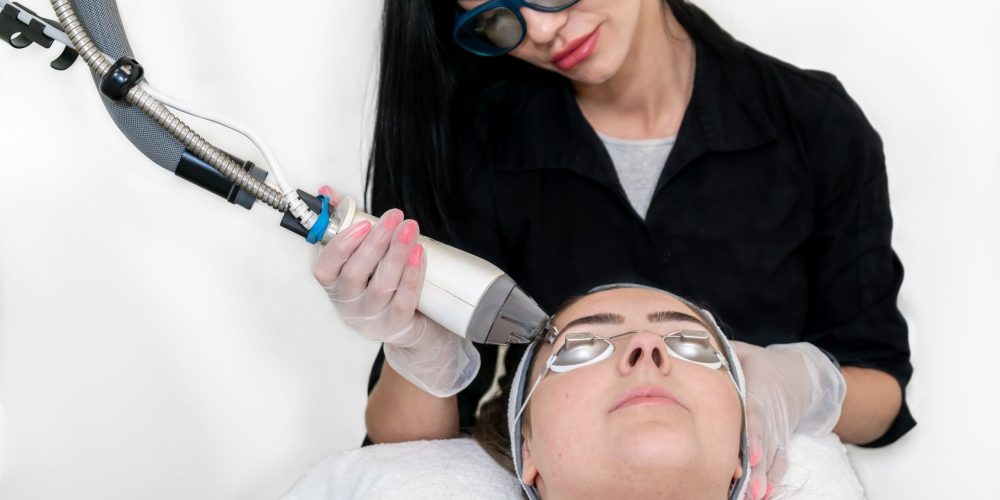Fraxel laser treatment has gained significant popularity recently as an effective solution for various skin concerns that range from sun damage and acne scars to wrinkles and pigmentation issues. However, one crucial question when considering this procedure is whether it is safe for all skin types.
Today, we will delve into the details and assess the safety of Fraxel laser treatment across various skin types. Read and discover for yourself the benefits this treatment can offer.
What is Fraxel Laser Treatment?
Fraxel Laser Treatment is a popular and effective skincare procedure that helps rejuvenate and improve the appearance of your skin. It’s like a magic wand for those wishing to say goodbye to unwanted scars, wrinkles, age spots, and other skin imperfections.
So, how does it work? The Fraxel laser technology uses fractional resurfacing, which treats only a fraction of your skin at a time. It delivers precise laser beams that create microscopic columns of thermal damage in the targeted areas of your skin.
You might have the same question, “Why would anyone want to damage their skin intentionally?” Well, here’s the exciting part! This controlled damage triggers the body’s natural healing process, stimulating the production of collagen and elastin—the building blocks responsible for youthful and healthy-looking skin.
As the damaged skin cells are replaced with new, healthier ones, you’ll notice a significant improvement in your skin’s texture, tone, and overall appearance. Fraxel Laser Treatment is especially effective for reducing the unwanted appearance of acne scars, wrinkles and fine lines, sun damage, and pigmentation issues.
One of the fantastic things about Fraxel Laser Treatment is that it’s customizable to suit your needs. Your dermatologist or skin care professional will assess your skin condition and adjust the intensity and depth of the laser treatment accordingly. This way, you can achieve optimal results while minimizing discomfort or downtime.
Speaking of downtime, you might experience some mild redness, swelling, and peeling after the treatment. Don’t worry; these side effects are temporary and typically subside within a few days. It’s important to follow your skincare professional’s post-treatment instructions and protect your skin from excessive sun exposure during the healing process.
If you’re considering Fraxel Laser Treatment, consulting a qualified professional specializing in skincare and laser treatments is essential. They will evaluate your skin, discuss your goals, and provide personalized advice on the number of sessions required to achieve the desired outcome.
Remember, Fraxel Laser Treatment is not a one-time solution; multiple sessions may be necessary to achieve optimal results. However, many people find the results well worth it, as they can enjoy smoother, younger-looking skin and regain their confidence.
Understanding Fraxel Laser Treatment
Fraxel Laser Treatment utilizes fractional laser technology, which delivers precise, controlled energy pulses to the skin to help stimulate collagen production and promote skin rejuvenation. This innovative technique works by targeting specific areas of the skin, leaving surrounding tissues unaffected. It resurfaces superficial and deep skin, improving texture, tone, and overall skin appearance.
During the procedure, the Fraxel laser emits high-energy pulses of light that penetrate the skin’s surface, creating tiny thermal zones within the skin. This process stimulates the body’s natural healing response, producing new collagen and elastin fibers. These essential proteins help to rejuvenate the skin, improving its tone, texture, and overall appearance.
Fraxel Laser Treatment offers a safe and effective solution for individuals seeking skin rejuvenation without invasive procedures or extensive downtime. Stimulating the skin’s natural healing processes helps restore a more youthful and radiant complexion. However, consulting with a qualified dermatologist or skin care professional is essential to determine if Fraxel laser treatment suits your needs and skin type.
Assessing Safety for Different Skin Types
Fair Skin
Fraxel laser treatment is generally well-tolerated by individuals with fair skin tones. Since fair skin has less melanin, there is a lower risk of post-treatment complications such as hyperpigmentation. Dermatologists often adjust the laser settings according to the patient’s skin type and condition to ensure optimal results without compromising safety.
Darker Skin Tones
While Fraxel Laser Treatment can be performed on individuals with darker skin tones, caution must be exercised due to the higher risk of pigmentation-related complications. Skin types with more melanin are prone to post-inflammatory hyperpigmentation (PIH) and hypopigmentation. To minimize these risks, dermatologists may use lower energy settings and employ a longer interval between treatment sessions for individuals with darker skin.
Sensitive Skin
Fraxel laser treatment is generally safe for individuals with sensitive skin. However, telling your dermatologist about your known skin sensitivities or allergies before the procedure is crucial. They can adjust the treatment parameters and employ appropriate post-treatment care to ensure minimal discomfort or adverse reactions.
Acne-Prone Skin
Individuals with acne-prone skin can benefit from Fraxel Laser Treatment as it targets acne scars and stimulates collagen production, leading to smoother skin texture. However, caution must be exercised if active acne lesions are present in the treatment area. It is advisable to address any functional acne issues before the procedure to minimize the risk of infection or scarring.
Safety Precautions and Considerations
To ensure the safety and effectiveness of Fraxel laser treatment for all skin types, it is essential to follow these precautions and considerations:
Consultation with a Dermatologist
Seeking a consultation with an experienced dermatologist is vital to assess your skin type, discuss your concerns, and determine whether Fraxel Laser Treatment suits you. They can customize the treatment plan according to your specific needs, minimizing the risk of complications.
Patch Test
A patch test may be performed before the treatment to evaluate your skin’s reaction to the laser. This test involves treating a small skin area to ensure compatibility and identify potential adverse reactions.
Post-Treatment Care
Following the dermatologist’s post-treatment instructions after a Fraxel Laser treatment is crucial in promoting healing and minimizing the risks of complications. This step may include applying soothing creams, avoiding sun exposure, and using sunscreen regularly.
Final Thoughts on Fraxel Laser Treatment
In conclusion, Fraxel Laser Treatment is a revolutionary skincare procedure that uses fractional laser technology to stimulate the skin’s natural healing process. Targeting specific areas helps improve the texture, tone, and overall appearance of your skin, reducing the signs of aging scars and sun damage. If you’re looking for one perfect way to rejuvenate your skin and boost your confidence, Fraxel Laser Treatment is just what you need!
If you are interested in experiencing Fraxel Laser Treatment, our wonderful friends at Isla Aesthetics can help you today. Visit them now!




